Archive for the ‘Success Story’ Category
SMJK Dindings – Media Archives
The Star – Perak school transformed to interactive management system

Original Story – The Star
BY CHAN LI LEEN
07/11/2004
LUMUT: From weather-worn wooden huts for classrooms and office buildings, SMJK Dindings in Pundut near here has emerged as one of the most IT-savvy schools in the country.
The 52-year-old school is the first to have a fully integrated School Management System using radio frequency identification (RFID) technology that enables it to record, access, report and manage performance records and data of students and staff in real time.
An attractive feature of the system, developed by Sibu-based company Perridot Systems, is that it allows parents to track their children’s performance and print out e-report cards.
The school’s principal, Tiong Ting Ming, who initiated and carried out the system after his transfer to the school in 1992, said all these functions could be performed anywhere in the world through the Internet.
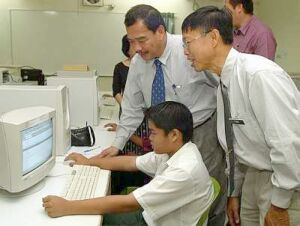
PRACTICAL SOLUTION: Tiong (right) and Kong observing Form Three student Loke Zhao Lin showing how the School Management System allows students to sit for a mock examination on Friday.
“All that is required is the password and one’s username. The system, however, has pre-defined parameters whereby an individual can only access information that is relevant to the person,” he told reporters here during a visit by Deputy Science, Technology and Innovation Minister Datuk Kong Cho Ha yesterday.
Tiong said the school was also using the system to track library loans, disciplinary records, and as a monitoring tool to record students’ punctuality and whereabouts.
“Each student has his own RFID tag. The student is required to scan it at readers within the school to keep track of his movement.
“The school and parents can confirm what time students arrive and leave, and their attendance at each classroom session,” said Tiong.
He said past and present students of the school had helped set up the system, including wiring up the school buildings with fibre optic cables.
“All equipment were either donated or bought second-hand,” he added.
Commending Tiong and the school for their efforts, Kong said having the School Management System had helped to boost the school’s reputation, and enrolment had risen from 320 students in 1992 to about 800 at present.
“The school’s popularity is growing so much so that parents are insisting on sending their children here,” said Kong, who is also Lumut MP.
He also urged Perridot Systems and the school to market the management system overseas.
“Software developed in our country are impressive but people have this mindset that they are only good if other countries have used them before.
“Therefore, the trick is to market them overseas first,” he added.
New Straits Times – They Made IT!

Original Story in New Straits Time
23/10/2001
TIONG Ting Ming is probably the best thing that has ever happened to sekolah menengah jenis kerbangsaan Dindings in pundut, Perak.

In less than five years, the 49year-old principal has done the near impossible.He has successfully turned a run-down school into one of the country’s celebrated and enviable cyberschools.
Today, SMJK Dindings has the information technology equipment and sponsorship that other school can only wish for.
Mimos Berhad provided the school with 32 fixed Internet Protocol (IP) addresses, fixed IP and a leased line which enable students and staff to access the web server from anywhere in the country.
Just last year, networking giant 3Com Corp sponsored a Wireless Ethernet system (802.11b) worth RM20,000, allowing notebook users to surf the Net hooking up to a telephone line.
Given all this, IT has undoubtedly become part or the school’s culture.
Tiong’s philosophy is simple. Everyone has to be IT-savvy, be they students, teachers or janitors.
“Therefore, for four periods a week, students attend IT classes where they learn to assemble computer parts and master complex programming software like C language,†he says.
Just like the students, the entire school staff too is made to attend IT classes. The teachers are encouraged to incorporate what they have learnt in their teacher.
Now, Power Point presentations substitute the chalk-and-talk method and homework for students is posted on the teachers’ self-create websites.
“In order to embrace IT, one must turn it into a lifestyle,†Tiong says.
He believes that schools should give students full access to the facilities and the complete trust to handle the technology responsibly.
“You can’t expect them to develop their fullest potential in IT when they can only use the facilities for a limited amount of time,†he adds, alluding to schools which limit students’ access to computer facilities for fear they will damage the expensive items.
Tiong says that mistakes will happen, but teacher should view them as part of a learning process.
Therefore, students of SMJK Dindings are allowed to use the facilities anytime they like, including after school.
As a result, the students are able to design their own websites, burn CD-ROMs, download MP3 files and take pictures using digital cameras using the facilities at school. In fact, the school’s website is maintained by the students.
Yet nine years ago, the school was literally falling apart.

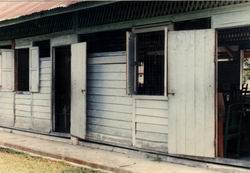
It was in 1992 when Tiong first set foot in the school. Small and secluded, it consisted of only three battered single-storey blocks.
The student population was 320 and dropping. Most of the students were more eager to land a job that stay in school did not have enough students to fill the From Four and From Five classes.
But Tiong saw it as a challenge to transform the school into what it is today.
He believed that a motivating environment will keep the students in students in school. And the lure of cybercafes, which were beginning to exert its influence among the young then, set him thinking.
“Why do kids like to frequent cybercafes?†he asks.
The answer, Ting says, is the environment and youths’ innate interest in all things new two-storey block in 1995 was the pivotal event to the school’s wondrous transformation into a Smart School.
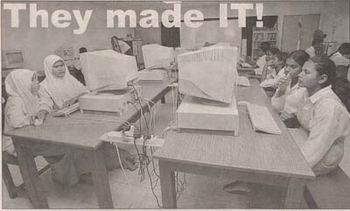
Tiong wanted it to be equipped with the latest telecommunications infrastructure.
To realize this ambition, fundraising events were held at the school. Tiong traveled long distances, swallowed his pride and knocked on the doors of doors offices to ask for sponsorship.
With the little money that the school raised, Tiong made bus trips to Singapore to try computer parts to repair old PCs.
But his perseverance has paid off. The generous sponsorship from various companies that Tiong secured means he does not have to travel so much, allowing him to concentrate on work at school.

He still buys computer parts but he does it the IT way now, from the auction website Ebay.com.
“I just carried out transaction with someone from Cincinnati, United States this morning .I can get computer parts much cheaper get computer parts much cheaper this way,†he says.
The number of students has also increased. The student population is now just a little over 800. Students no longer flee from the school – they actually apply to be accepted.
Despite being a self-professed “science†person, Tiong had little qualms about removing Biology from the school syllabus and replace it with IT.
An unorthodox move indeed, but the principal feels that he has given the students a better alternative. Parents and students seem to agree with him because SMJK Dindings has not lost any students due his firm stance.
In fact, it is the rival schools who are their students to SMJK Dindings. Now they too have introduced IT in their schools to avoid students “migrationâ€.
But before more parents start clamouring to register their children with SMJK Dindings, the coveted school wants to make one things clear.
It may be the best Smart School around , but it is not the best in overall academic excellence.
Tiong says: “we are average performance-wise. Although we have the facilities, it is unfair to equate the amount of investment we have put into this project with the students’ performanceâ€.
A believer of lifelong learning, he is not so concerned about academic performance. He is in more proud of the fact that his students have evolved from self-conscious kampong kids into confident, independent and responsible citizens.
Having only six more years before retirement, Tiong is not too sure if he want to leave quite so early .
“ But I have considered the possibility of leaving the school and providing my expertise to other schools, and doing more for my country.â€
But when the time comes, Tiong hopes that his replacement will be someone who has the same interest and foresight.
“I have laid the foundation. The infrastructure and culture are there. It is up to him or her to develop and adopt it to his or her approach.â€
One thing is certain. The struggle must continues for the sake of the students.
“Kampung kids don’t have ample opportunities to realise their dream.â€
Thanks to Tiong, they do now.
The Sun Daily – Headmaster turns rundown school into high-tech centre

Original Article – By Muhammad Husairy Othman
muhd@thesundaily.com
LUMUT, Sun: SMK Dindings principal Tiong Ting Ming is living proof of the adage the word “impossible” only exists in the dictionary of fools. The fact is this gentle-looking 49-year-old man has achieved a gargantuan feat. He single-handedly turned a dilapidated school into a high-tech learning institution.
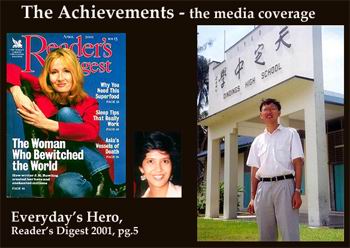
His achievement even caught the attention of the Readers Digest which featured him in an article entitled Everyday Heroes. During a recent interview with The Sun, the father of three was more than eager to share his thoughts and challenges in undertaking a task which was once look upon by the local community as impossible.
It all started in 1992 when he was promoted as principal of the school whose reputation rested more on its termite-infested wooden buildings, and with an enrolment of about 300 students. The condition of the school left Tiong in shock when he first set foot in it. Tiong decided to do something about it – he gritted his teeth and began to revamp the whole school turning it into a high-tech learning institution. From then on until August 1997, he practically begged and twisted the arms of many people into donating for his cause, netting more than RM1 million in cash and kind.
All this went into the renovation of the older blocks and the construction of a three-storey building which he lovingly refers to as cyber classrooms. “The whole building is interlinked via conduits for data cables.” In fact all the buildings in the school are interlinked via Local Area Network (LAN) while the fixing of the fibre optic cables were undertaken by Thomas & Betts, a US- based company, he said.
Having achieved this, he strived harder to get more donations to set up three computer laboratories in the new building and managed to raise another RM800,000 last year. He also envisioned setting up a school which provides state-of-the-art Information and Communication Technology (ICT) for students. He managed to sell this idea to several big corporations.
Among the major corporate sponsors who helped were Sapura IT which contributed 25 personal computers and the LAN system worth some RM150,000. Mimos provided the school with Internet connection worth RM60,000 while Thomas & Betts came in with fibre optic cables worth some RM100,000.
Hock Hua Bank Bhd donated 60 units of 486-100 NEC central processing units while 3Com Asia Pacific Ltd lends a helping hand with the technical aspects under the Netprep programme. NetPrep Curriculum & Equipment provides the school with the necessary teaching syllabus and course materials in a bid to ensure the whole programme is a success.
Despite having all these facilities, each student is only charged a nominal fee of RM10 per month while the Parents and Teachers Association (PTA) sponsors 50% of the RM10 for each poor student. Apart from being the only school in Perak with all these facilities, the school also makes it compulsory for all its form five students to take IT as one of the subjects in their Sijil Pelajaran Malaysia (SPM) examinations.
The pioneer group of students who sat for the examinations last year did exceptionally well with only four failures out of 104. Even the teachers in the school were not “spared” the innovations as Tiong has made it compulsory for them to attend at least 1 1/2 hours of computer classes every week.With the availability of such facilities coupled with Tiong’s commitment to the welfare of his charges, student enrolment jumped to an all time high of 879. “I plan to limit the number of students to 600 by next year to have a more conducive learning environment.” A strict disciplinarian, the bespectacled Tiong also had his fair share of encounters with stubborn and naughty students who broke the windscreen of his car and splashed paint on it.
“They did not take too kindly to me initially,” he smiled while pointing out that character building and mutual trust takes time to develop. Now he even lets the students have access to the computer laboratory after school hours,
and if they have certain projects to complete, they are allowed to use it in the evening in the main server room.
Another factor which makes the Sitiawan-born Tiong stand out from others is that he has no background in IT and yet he supervises and monitors the LAN system in the school. “I read a lot and this has enabled me to keep abreast with the latest changes in IT,” he said while pointing to a three-metre high bookshelf packed with numerous publications on the subject. “If I want my students to be self-learners, I must be one myself.” But no tall is over for the SMJK Dindings. Tiong still has the arduous task of making ends meet as the school needs about RM5,000 in donations, monthly. “This is my main problem. I am here before 7am and go home only after sunset.”
All Content Copyright © 2001 The Sun Media Corporation Sdn. Bhd. Produced by
SunCities.Net.

Original Article Published in ZDNet Asia, June 29, 2000
by Anita Devasahayam
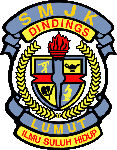 LUMUT, Malaysia: You may not find the Dindings High School, located in the hinterland of Malaysia’s northern state of Perak, on any map, and may pass it by without a second thought.
LUMUT, Malaysia: You may not find the Dindings High School, located in the hinterland of Malaysia’s northern state of Perak, on any map, and may pass it by without a second thought.
But located within its wooden walls and under zinc roofs are budding entrepreneurs of the new dot-com world.
The 800 students of the school, ranging in ages between 13 and 17, surf the Internet, learn Web design, digital art, networking, and programming in C, Visual Basic, Linux and Unix as part of their daily curriculum.
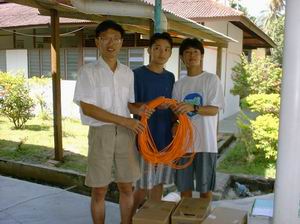
In their most recent school project, a group of 20 students received hands-on experience in laying a one-km 10Mbps fiber-optic cable to inter-link the school with a nearby primary school and kindergarten. The campus-wide high-band network was probably the first of its kind in the country that was commissioned and maintained by teenagers. The new link-up will enable students and teachers to experiment with classroom-to-classroom video-conferencing and other multimedia applications.
“By the time these students leave school, they will have enough technical know-how and skills to configure and use switches and hubs and manage networks,” said principal Tiong Ting Ming who is the driving force behind the rural school’s transformation.
Eight years ago, the radical 48-year-old principal, was assigned to the Dindings school located near the beachfront town of Lumut, where the community’s lives are mostly centered around trading, fishing and agriculture.
Tiong had come with the belief that the textbook-reliant, exam-oriented education system the school was governed by was not enough to equip his students to participate in a globalized economy. Added to that the less-motivated students were dropping out and he needed to stem the tide.
An Apple Macintosh fan, Tiong was switched on by the opportunities that computing technology could give his young charges. “One of the hardest things was convincing some of the more skeptical parents and technophobic teachers that computers are necessary to give the kids skills they could use in the real world,” he said.
When the Internet came along, it served to reinforce Tiong’s belief that he needed to arm his students for the future knowledge workplace. “The Internet is their future. I was convinced educating them to be responsible Net citizens and giving them the right skill sets had to start in school,” he said.
Persistence pays
A chemistry graduate, Tiong set about teaching himself to repair and upgrade old PCs and cajoled teachers and students to embrace the Internet. Only partially supported by government and without the cash-rich opportunities of urban schools, Tiong knocked on doors of corporations and benefactors to win them over.
“I visited one company in Kuala Lumpur seven times before they finally relented and gave me the first set of PCs and Macs to get us started,” said Tiong.
He also travelled personally on 800-km bus journeys to-and-fro Singapore to purchase spare parts to refurbish second-hand computers for his students. “Computer parts are expensive in Malaysia and are much cheaper from bargain hardware purveyors at Sim Lim Square in downtown Singapore,” he said.
With the aid of former-students, some generous individual donors, various companies, and the Ministry of Education, the school has since raised over 1.8 million ringgit (US$470,000), in cash and kind, to fund its efforts to build up a networked environment from scratch.
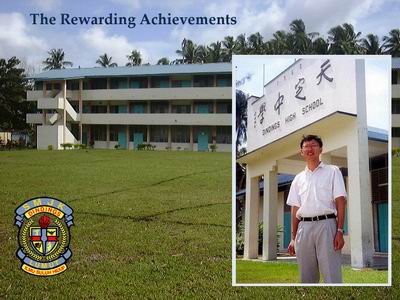
Wedged between a palm oil estate and a coconut plantation, the school now boasts a brand new three-storey block that is a hive of computing activity. Tiong’s office is more akin to a computer retail shop’s back-office, and is packed with an assortment of PCs, servers, peripherals, cables and an over-laden shelf filled with phonebook-sized technical manuals and books.
His open-door policy, during this interview, saw busy students come in armed with some component or another, then skitter off spouting geekspeak. Amid the clutter in the room there is even a bed to get some shut-eye and a fridge for snacks when his students are working on late-night “projects.”
One of those projects, administered by Tiong, was the wiring of the entire school including the classrooms, the library, the staff room, the administration office and computer labs.
The school now has over 100 PCs – 486s, Pentium 75s and Pentium MMX 166s – that give students and teachers instant access to the Internet via a 64Kbps leased line.
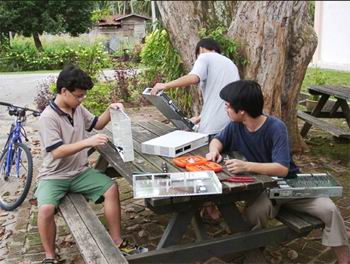
A cadre of trained students upkeep the PCs and administer the Dell 553MHz dual -processor main server, and a self-configured secondary and backup server.
The Red Hat Linux 6.1 powered-server houses their mail server, Apache Web server, proxy server, newsgroups, Internet Relay Chat, and file, print and backup server.
‘I chose Linux because the system cost me only 200 ringgit and was useful for my students to learn and configure,” he said.
Sowing the Net generation
Early last year, Tiong yanked biology as a subject from the curriculum for his Form Four (16-year-old) students and replaced it with information technology. “Better to know the innards of a computer than human or animal anatomy,” he thought.
He has since extended the subject school-wide, and all students have their own individual email and attend varied courses ranging from basic software to hardware troubleshooting and maintenance, programming, local area networking, and structured cabling and certification.
Students are also assigned projects by teachers to encourage them to do research on the Internet to complement their traditional subjects.
This year, a pioneer batch of 120 students will be taking Information Technology as an exam subject for the year-end compulsory government examinations, that is a prerequisite for university entrance.
Networking giant 3Com Corp adopted Dindings as the first of 11 schools in the country for its global NetPrep program to provide students with network management skills.
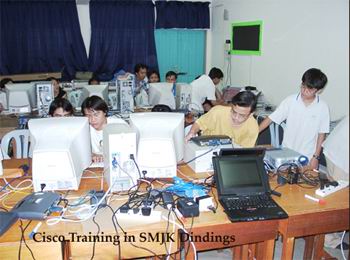
The first batch of 20 students are currently undergoing 160-hours of the intensive program and will be certified by the International Association of Communication Systems Engineers upon completion.
Tiong believes the hard work has begun to pay off. “I used to have to persuade parents to keep their children in school. Now I get queries from far and wide to have their children sent here,” he said. The student population has grown steadily, in tandem with the school’s computing firepower, from 320 to the present 800.
He discloses that school’s passing rate in year-end exams, a government barometer for a school’s success, is still only around 50 percent. “But their environment is sheltered. Introducing the Internet to the students has opened their minds tremendously and given them insights and the motivation to be discerning and analyze information,” he said.
Tiong said his ultimate goal is to provide an environment where the “Net culture” can thrive. He hopes students can be imprinted with a self – and life-long learning trait that they could retain beyond school walls.
He added that teachers in the country need to bone up to adapt to the rapidly shifting educational needs of students. “Teachers are at risk of becoming obsolete if they do not understand nor accept that they no longer hold a monopoly over the input their students receive. They must become as Net-savvy as their students. You can ignore the technology, but not the information,” he said.
Tiong is convinced the information technology skills his students acquire will equip them for life in the real working environment and to be more responsible with the use of the technology. It may even inspire some to become entrepreneurs. As Tiong puts it: “You can either be a paddy planter or rice eater. I am teaching my kids to be planters because that’s their future ricebowls.”

Published in ZDNet Asia
by Anita Devasahayam
Cnet Asia – Every school needs a champion

Published in CNET Asia, Apr 24, 2000
by Anita Devasahayam
Every school needs a champion
Date: Friday, November 24 @ 20:45:19 MYT
Topic: Smart Schools
Three weeks ago, three friends from Sun Microsystems and I visited Malaysia’s most happening school–SMJK Dindings. Stuck out in the middle of nowhere amid an oil palm estate and a fishing village, SMJK Dindings is probably the most wired public school in the country today.
The story behind this is worthwhile recounting.
School principal Tiong Ting Ming spent his first seven years there raising RM500,000 for a new school block complete with underground trunking. He lobbied and secured sponsorship in kind from U.S. power company Thomas & Betts, networking giant 3Com Corp and local conglomerate Sapura Holdings. He recruited his former students, who ran MyDirectory Sdn Bhd, to help out with troubleshooting and maintenance. Many more good souls, touched by Tiong’s quest and impressed by his perseverance, sent money. Even his 15-year-old son, a student there, was roped in to be systems administrator.
For the next two years, Tiong and his students kept plugging on, single-handedly refurbishing computers for a local area network, porting over applications, and setting up servers for specific functions.
News of this cyber school soon spread within its vicinity, and before long the student population had grown from 320 to 800-plus. Today, SMJK’s population of teenagers are more comfortable reading Linux, Macromedia Flash, Ethernet Gigabyte and other computer-related manuals than fiction. Most of the students harbor dreams of running their own IT startups or joining the industry as COOs, system engineers, technicians, analysts and Web designers.
And all because one man dared to dream.
A one-man crusade
The first time I visited the school in July 1998, I was skeptical about Tiong’s ability to pull off this grand vision. As a seasoned journalist, I had seen enough failure in school computer laboratories and met even more headmasters too caught up with administrative matters to push the technology envelope.
Cost was another prohibitive factor. The majority of 8,000-plus schools in Malaysia survive on a stipend from the Government. Year in year out, these schools concentrate their efforts on raising funds either to build a new school wing, buy furniture, pay the electricity bills, or on repainting. Ironically, these schools are located not in the boondocks, as one would think, but within city centers.
Tiong, like his town counterparts, faced similar problems. Raising funds for a new building was a nightmare. It took him five years to find the money for a new three-storey block before he could consider equipping the school with second-hand computers and getting them networked. After all, obsolete machines have little value unless they are linked to a powerful server.
His bait to hook the students’ interest in technology was to provide them unfettered access to the school computers and the Internet. He gave each an email address and Web space to design their personal homepages. Naturally, he does not condone roaming into restricted parts of the Net and has a proxy server tracking the movements of students online.
Having incorporated IT as part of classroom learning, the students are now clamoring for more hours on the PC.
Tiong’s peers have traveled across the country to see for themselves SMJK’s remarkable achievements. What these school principals fail to consider is that Tiong started out from ground zero. Like his students, he had to learn everything on the go. But his single-minded pursuit to create a tech culture in his school and his belief that equipping students with the practical IT skills that have provided the conduit for the project’s success.
Leap of faith
Last year, Tiong had an opportunity to deliver a presentation to a group of Singaporean school teachers. The majority of Singapore schools, unlike Malaysian ones, are wired. The Singapore Government is perhaps more diligent than its Asian counterparts in ensuring that all schools are properly equipped with computers and the right infrastructure to ensure they are groomed for the knowledge-based economy.
Singapore students are also more fortunate in that each school has a dedicated staff in charge of IT development. This person sees to the needs of the students in harnessing IT and ensures that the necessary infrastructure is in place to support this exercise. The Government’s aim is to create thinking schools in order to breed a learning nation. A new syllabus has been developed that comprises three new skills–entrepreneurship, thought and creativity.
So when Tiong stood up at the podium, the last in the series of speakers that evening, the audience were prepared to leave. How could a single principal from some backyard school impart what the Singapore teachers already knew or had in their schools?
Unfazed, Tiong pulled out his Powerbook and loaded a CD-ROM created by a group of his students. Its contents showcased the early beginnings of SMJK Dindings and the achievements in the last seven years. In his not-so-fluent English, Tiong won the audience over with his sincerity and dogged belief that it only takes one person to make the difference.
My friends at Sun were also equally impressed after touring the school premises, and like their 3Com counterparts who had signed the school under the company’s Netprep program, the Sun respresentatives expressed an equal desire to contribute to the school.
What they didn’t realize was that 3Com hadn’t found Tiong. Tiong had found them.
As this visionary says of his continuing quest to bring his students into the future: “I teach the students to plant paddy, not merely to eat from their rice bowl.”

Published in CNET Asia, Apr 24, 2000
by Anita Devasahayam
CNet Asia – A fully-networked school rises in rural Malaysia

Original Article Published in CNET Asia, Nov 04, 1999
by Julian Matthews, Malaysian correspondent
LUMUT, Perak–If a school can be described as four walls with the future in it, then the Dindings National-Type Secondary School in rural Perak has confirmed its place in the new millennium.
Situated 95km from the nearest city Ipoh, the school is mostly made up of wooden buildings and wedged between a palm oil estate and a coconut plantation.
But running under the floors and in conduit piping along the corridors are Cat-5 networking cables inter-linking 70 PCs in the classrooms, the library, the staff room, the administration office, the science labs and computer labs. Every room has RJ-45 connectors that gives it instant access to the Internet on a 64Kbps leased line.
The school was wired almost entirely by its students who manage and administer the Redhat Linux 6.0 powered-server which houses their mail server, Apache web server, proxy server, newsgroups and Internet Relay Chat. “All my 690 students have their own email, can design homepages and do Linux, Unix and C programming,” said principal Tiong Ting Ming, 47. Students in the school range from 13 to 17 years of age.
Ironically, the school is not part of the 90 schools chosen as part of Malaysia’s Smart School Program which has been sharply criticized by the opposition for delays and faulty courseware.
Tiong spent seven years cajoling local corporations and benefactors to provide funding to transform the school into a network-ready environment for his students. Total investment currently amounts to RM1.8 million and major sponsors include Sapura Holdings, Mimos, Thomas & Betts and the Ministry of Education.
Tiong’s dedication earned the school its latest sponsor–networking giant 3Com Corp. 3Com Wednesday showcased the school as one of only two schools in Malaysia and 30 in Asia that are part of its global NetPrep program to provide students network management skills training.
3Com which organized the media tour donated RM32,000 worth of networking equipment and together with Universiti Tun Razak, will initially train a core group of 10 boys and four girls.
Students who complete the course will be certified by the International Association of Communication Systems Engineers.
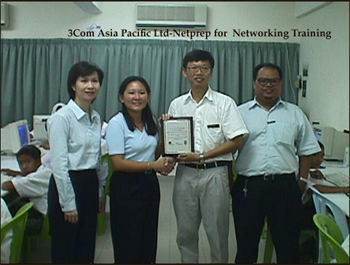
3Com Asia Pacific education and training manager Daphne Tham said: “We are preparing students of today for the workforce of the 21st century.” About 200 schools and tertiary institutions worldwide have joined the NetPrep program.
Tham said 3Com was wary of the program being positioned merely for elite schools and Dindings was a prime example of its reach even in rural areas.
Principal Tiong said his mission is not just to impart knowledge from textbooks but to create a “Net culture” where students will be attuned to self- and life-long learning and retain this trait beyond school walls. “The Internet is their future, educating them to be responsible Net citizens has to start now,” he said.
This year, the radical principal yanked biology as a subject from the curriculum and replaced it with information technology. Next year, IT will be offered as an exam subject for the first time for the year-end compulsory government examinations.
“Next month, my students will also install and commission a fibre-optic backbone from the school to the primary school and kindergarten next door,” said Tiong who plans to raise the student-to-computer ratio from the present 12:1 to 5:1 and add a 128Kbps ISDN Internet link-up soon.
Student Ho Guan Hwang said: “When my principal told us four years ago he was going to wire the school, I had my doubts. Today I know about the Net and can learn how to install fiber cables and have networking and programming skills. All this is so expensive to learn. We are very lucky we can do this in school.”

Note: Published in CNET Asia, Nov 04, 1999
by Julian Matthews, Malaysian correspondent
